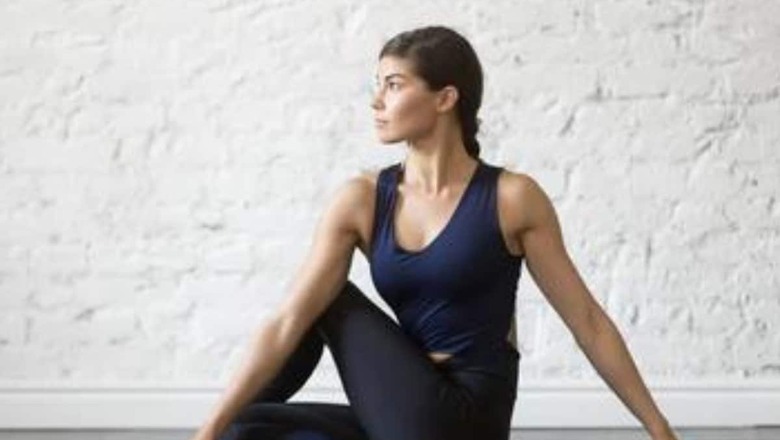
views
Stress, anxiety, and other mental health issues have become increasingly common these days. To enhance their mental well-being, many individuals are seeking holistic approaches which includes adapting a healthy lifestyle backed by exercise, walking and more. However, apart from these, practising yoga also offers a powerful solution. With its combination of physical postures, breathing exercises, and meditation, yoga can be a transformative practice for mental health. Pritika Singh, CEO Prayag Hospitals Group shares five yoga practices that are particularly beneficial for promoting mental well-being:
- Savasana (Corpse Pose):
The simplest yet most profound yoga practice for mental health is Savasana, also known as the Corpse Pose. As the name suggests, it simply involves lying down on your back, completely relaxed, with arms by your side and eyes closed. Savasana helps calm the mind, reduce stress, and induce a state of deep relaxation. This pose promotes a sense of inner peace and rejuvenation, reducing anxiety and improving sleep quality.
- Pranayama (Breathing Exercises):
Another one is Pranayama which is the practice of controlling the breath. It is considered to be the cornerstone of yoga that significantly impacts mental well-being. It includes techniques such as deep abdominal breathing, alternate nostril breathing, and the victorious breath (Ujjayi Pranayama) that help regulate the nervous system and bring about a sense of calmness and mental clarity. By focusing on the breath, pranayama cultivates mindfulness, reduces stress levels, and promotes emotional stability, making it an excellent practice for anxiety and depression management.
- Yoga Nidra (Yogic Sleep):
Yoga Nidra, also known as yogic sleep, is a guided meditation practice that facilitates deep relaxation and heightened self-awareness. Yoga Nidra induces a state of conscious deep sleep, allowing you to access the subconscious mind and release mental and emotional blockages. It involves lying down in a comfortable position while listening to a guided meditation that takes you through different stages of relaxation. Regular practice can ease out symptoms of post-traumatic stress disorder (PTSD), insomnia, and anxiety, while enhancing overall mental resilience.
- Siddhasana (Accomplished Pose):
Siddhasana, also known as the Accomplished Pose, is a classical seated posture used in yoga and meditation practices. It is considered one of the most effective and powerful sitting poses for spiritual and energetic purposes. The term “Siddhasana” is derived from two Sanskrit words: “Siddha,” meaning “accomplished” or “perfected,” and “asana,” meaning “pose” or “posture.” This pose is often used for meditation due to its ability to create a calm and focused state of mind. The seated position and the alignment of the spine in Siddhasana promote mental focus and concentration, making it easier to engage in contemplative practices. Siddhasana is said to awaken and direct the flow of prana (life force energy) in the body, leading to increased vitality and improved overall health.
- Balasana (Child’s Pose):
Another yoga practice that is useful to tackle mental health issues is Balasana, also known as Child’s Pose. It is a popular yoga posture and involves a gentle, kneeling pose, providing a sense of comfort, calmness, grounding and several other benefits. This yoga posture gently stretches the hips, thighs, and ankles, while also releasing tension in the lower back and shoulders. The pose helps to calm the mind, reduce stress, and promote relaxation. It can also be used as a resting position during a yoga practice or as a counterpose to more vigorous postures. However, Balasana may not be suitable for everyone. If someone have knee or ankle injuries, it’s advisable to use props like a bolster or folded blanket to support your body and make the pose more accessible. It’s always a good idea to listen to your body and modify the pose as needed to ensure your comfort and safety.
As with any yoga pose, it’s important to listen to your body and modify the pose as needed. If you have any specific health concerns or injuries, always consult a qualified yoga instructor first. Overall, the ancient practice of yoga offers a holistic approach to mental health and well-being. The beauty of yoga lies in its versatility, making it accessible to individuals of all ages and physical abilities. The above-mentioned yoga practices provide invaluable tools to navigate life’s challenges, manage stress, and nurture a profound connection between the mind, body, and spirit. So, whether you’re a beginner or an experienced practitioner, incorporating these yoga practices into your daily routine can contribute to optimal mental health and a more balanced and fulfilling life.



















Comments
0 comment